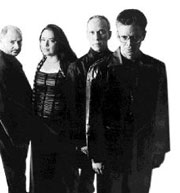Since their low-key inception in 1973 (right here in Seattle), the Kronos Quartet has become the only quartet (heck, the only chamber music ensemble of any kind) whose name has a plausible claim to being a household word. For one thing, the music they program sits on the other end of the classical spectrum from most every other quartet’s; the 20th-century avant-garde music others perform sparingly in their repertory has cemented Kronos’ reputation. They, in turn, skip over the 18th and 19th centuries completely.
Kronos Quartet
Moore Theatre, Saturday, January 27
Embracing rock and jazz (most notoriously a churning rendition of Hendrix’s “Purple Haze”), Kronos bucks classical music (and certainly string ensemble) trends in more ways than one. At a time when the rest of the classical world obsesses over bringing in a younger demographic (falling right in line with our consumerist society’s belief that if white males aged 18-35 don’t want something, nobody should get it), the seriousness of Kronos’ approach suggests that they program “crossover” repertory for musical, not financial, reasons. This music simply deserves to be heard alongside Bartok, Shostakovich, Carter, and the rest of the “classical” modern quartet canon.
This Saturday they’ll play a typically fascinating program, including Steve Reich’s Triple Quartet, in which Kronos plays along with prerecorded tapes of themselves; Three Scenes from An Duong Vuong by P.Q. Phan, who captivatingly combines Eastern and Western influences; “Myself When I Am Real” by Charles Mingus; and Peteris Vasks’ Quartet no. 4, which, like the majority of Vasks’ music (and like that of his regional colleagues Schnittke, P䲴, Gubaidulina, and Kancheli), finds transcendent beauty in emotional devastation. Even if they weren’t renowned for their innovative programming and for the visceral power of their performances, Kronos would still reign in the front rank of the quartet field for their technical precision and focus—qualities long apparent in their extensive discography and that haven’t changed in the least since cellist Jennifer Culp (formerly of the Philadelphia String Quartet) joined violinists David Harrington and John Sherba and violist Frank Dutt in 1999.
Any personnel change is traumatic for a quartet—”divorce” is not too melodramatic a description. The Tokyo Quartet’s recent changes have been a little bumpier than Kronos’. The last time I heard the Tokyo Quartet in Seattle, in 1997, their first violinist, Mikhail Kopelman, was brand new to the group. He hadn’t quite settled in, and both their playing and their program choices seemed a little overly cautious. Their January 17 Meany Hall appearance brought yet another new member, cellist Clive Greensmith, whose initiation has gone more smoothly.
The high point of their program (Mendelssohn’s op. 81, Schubert’s Quartettsatz, and Beethoven’s op. 127) was the slow movement of the Beethoven. Their performance showed off amazing color nuances, from a drier, slightly “fuzzy” tone to a juicier, more sonorous one, and they were able to effect these changes both individually and as an ensemble, based on the expressive needs of the moment. This was quartet playing at its highest level.
The Tomasini Quartet, Seattle’s premier period-instrument quartet (violinists Sandra Schwarz and Mary Manning, violist Laurel Wells, and cellist Meg Brennand), provided another stunning lesson in one of the basic questions of quartet playing: unity vs. individuality, or when should the group sing as one and when as four? They offered gorgeous examples of both extremes within one work—Mozart’s Quartet in G, K. 387—at their Town Hall concert January 14.
The Tomasini played the opening passage with a flawless unity of phrasing and timing that became even more impressive by their rhythmic flexibility. But to start the finale, players took exactly the opposite approach, emphasizing maximum musical fragmentation in the music’s wispy arching phrases and offbeat sighs, which floated by with no clear-cut sense of pulse. In this quartet’s expert hands, their period instruments produced an ethereal, even disembodied, timbre that made this spacey effect possible to a degree that richer, bolder-toned modern instruments would never be able to.







